This was published 1 year ago
‘I learned on the job’: Ben Mendelsohn’s new look
Captured by the lens of cinematographer Jaime Reynoso, Ben Mendelsohn’s Christian Dior cuts a slender, stylish figure in Apple TV’s The New Look. Mendelsohn delivers a luminous performance, played with nuance and subcutaneous emotion. What is not immediately apparent is that it all started in the most unpretentious of places: footy games and pizza nights.
Behind the new series sits an important friendship between Mendelsohn and writer/director Todd A. Kessler, formed in 2015 when Kessler cast Mendelsohn as family black sheep Danny Rayburn in his critically acclaimed Netflix thriller Bloodlines. Since then, the 54-year-old Melbourne-born actor says, an enduring friendship has formed.
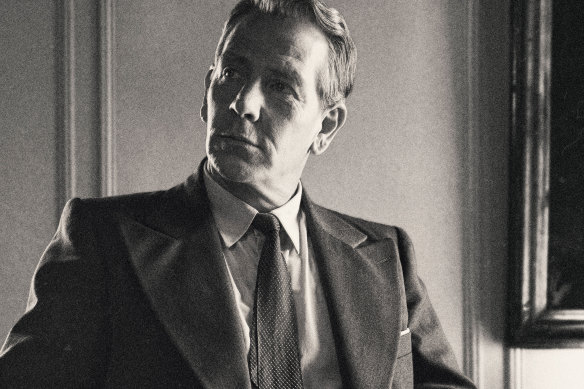
Ben Mendelsohn as Christian Dior in The New Look.Credit: Apple TV+
“Todd is the easiest person, the most unstressed, unpretentious sort of person to be around,” Mendelsohn says. “I’ve taken him to meet everyone. I’ve taken him to the footy with all my mates. He’s one of those kind of guys. It was definitely the Roosters, but I can’t remember who they were playing,” adding with a grin: “I wish it was a Storm game because obviously, we’re better.”
The New Look sprang into being one night when Kessler “was at my joint, and he was knocking up a pizza from scratch,” Mendelsohn says. Kessler, who is a passionate reader of biographies, had started talking about the renowned French fashion designer Christian Dior, and about Dior’s “personal self, like an authentic self, if you like, and this other self, which he hates. He hates himself for not being able to be his authentic self while he conducts his business.”
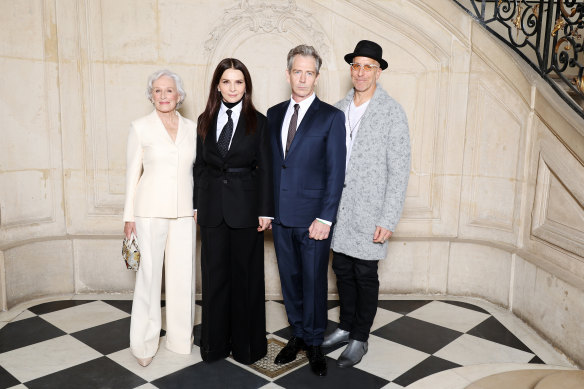
Glenn Close, Juliette Binoche, Ben Mendelsohn and Todd A. Kessler attend the Christian Dior Haute Couture Spring/Summer 2024 show as part of Paris Fashion Week.Credit: Getty
“I just turned to him and said, well, when can we do this? Because I didn’t need any more than that,” Mendelsohn adds. “That’s such a universal kind of starting place. And I just went, well, when can we do it? Because after Bloodline, I’d do anything to try and work with him again on something where we’ve got a shot.”
In its final form, The New Look has more than a shot. It comes with a brilliant cast: Mendelsohn as Dior, French star Juliette Binoche as designer Coco Chanel, John Malkovich as Lucien Lelong, the French couturier in whose workroom Dior’s career began, and Game of Thrones star Maisie Williams as Dior’s sister Catherine, a French resistance fighter.
Written by Kessler with Jason and David Rabe, Amanda Coe, Carter Harris, Dani Vetere and Ning Zhou, the series explores the rise of Dior, his creation of “the New Look”, which revolutionised French fashion, his rivalry with Chanel and his close connection to his sister Catherine. Featured among the supporting cast: Cristobal Balenciaga, Hubert de Givenchy, Pierre Cardin and others. In terms of modern fashion history, it is an A-list lineup.
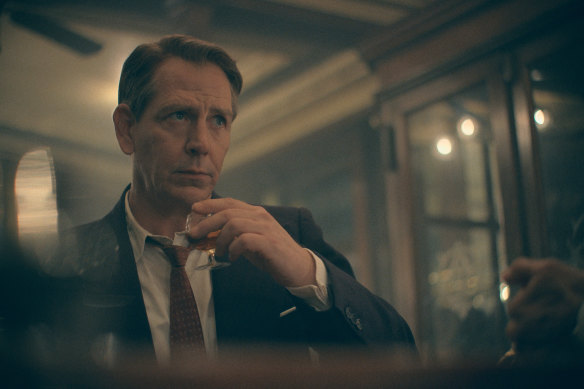
Ben Mendelsohn as Christian Dior in The New Look.Credit: Apple TV+
That “the New Look” was transformational for the Christian Dior brand speaks for itself. Founded in 1947, it took just seven years for Dior to account for half of Paris’s fashion export industry. It is owned today by the luxury conglomerate LVMH Moët Hennessy Louis Vuitton, headed by Bernard Arnault.
For Ben Mendelsohn, a boy who was raised on the outskirts of Melbourne, however, that’s a lot of haute couture history to take in. What does the starting point for researching a role like this look like? I ask Mendelsohn. “It looks bare,” he replies, smiling.
As an actor, he explains, he began with the man more than the world he inhabited. “When you’re coming at it, from my point of view, it looks like you want to build a frame, just a frame, and you don’t want to concern yourself where everything’s going to go and get all wound up in that because that’s not where the action is,” he says. “The action is this little field where you can try and surf.”
Mendelsohn took in “a sense of curiosity, unsureness, and I wanted to make sure I could hear the other person. That’s what I wanted to do. To try to get the mechanics of the accent, a sense of what the fabric world is like, what this is like, the family life, that kind of stuff. And that’s it. That’s it.”
Why? “Because I got taught by [Anthony] Hopkins something very, very important, and it changed the way I worked,” he says, declining to go into the details of what was contained in Hopkins’ acting tutorial. [The pair worked together on Spotswood in 1991, when Mendelsohn was just 22.] “I learned along the way,” he adds. “I learned on the job, talking to people.”
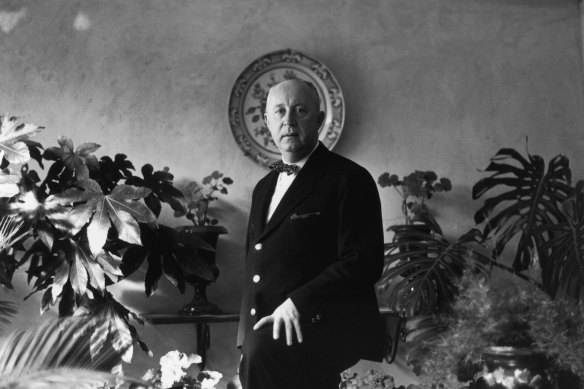
French designer Christian Dior in 1957.Credit: Snowdon/Camerapress
Perhaps the most striking revelation in the scripts themselves is not so much that life in World War II-era Paris was complicated – it was, as the history books attest to – but that not everyone’s loyalties lay where you might assume. Louis Vuitton, for example, had ties to the French [pro-Nazi] Vichy regime. Hugo Boss designed Nazi uniforms. Chanel was, for all intents and purposes, a Nazi spy. Cristobal Balenciaga was close to Spain’s Hitler-ally, General Franco. The list goes on.
Mendelsohn refrains from weighing in with an opinion except to say, essentially, that the historical record is there for examination. “I think as Aussies, we have a really strong sense of certainty about certain things; we have a high barrier for what’s good and what’s not,” he says.
What is in the series, he adds, is “the journey of that and the journey of how do you be in the world when you have this self that you don’t necessarily feel an overwhelming greatness about? How do you interact with it with values, integrity that meets reality and [situations where] you must adjust or fall off the side″.

Christian Dior with his New Look models in London in April 1950.Credit: Getty Images
“In the modern world, that’s got a really beautiful message because [Dior] is a very sensitive person, he’s a person with a lot of insecurities, a lot of doubt. He doesn’t feel good about himself in many, many ways,” Mendelsohn says. “And yet he steps forward.”
Kessler, speaking in a separate conversation, attributes what many might feel is a free pass for a brand like Chanel, to the slow exposure of the extent of Coco Chanel’s interactions with the Nazis. Much of the detail was kept in government archives which were not released until years after the war, “and by then, many of the people spoken about had passed away, and it didn’t make much news at the time”, Kessler says.
A few days before our interview, speaking at a press event, Mendelsohn articulated the struggle to position the work of artists in the wider spectrum of both their personal politics and, in Chanel’s case, events taking place around her.
“I think that you can admire the work, you can be moved by the creation, and you can have a sense of that person behind it or not,” Mendelsohn said. “It doesn’t stop the power of the creation and as to how one feels about the person, well, that’s dependent on any number of things.
“We’re not trying to paint sort of a moral story here, we’re just really trying to look at the circumstances and people that are trying to find their way through it and how they do it, coming from where they come from,” Mendelsohn added.
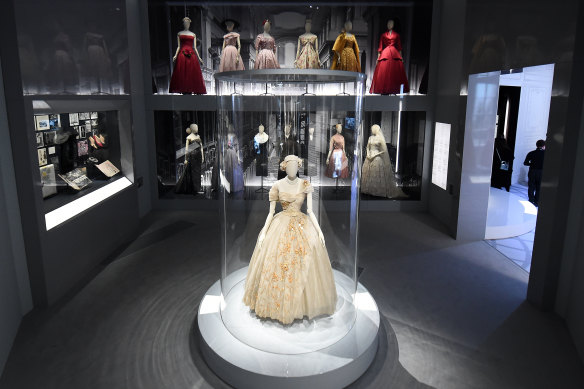
Designer pieces on display during the Christian Dior: Designer of Dreams exhibition at Victoria & Albert Museum in London in 2019.Credit: Getty
To some extent, Dior himself comes out of The New Look historically unscathed. At the same time, Caroline Bongrand, the fashion historian and former editor-in-chief of the fashion magazine L’Officiel, has described Dior as a man who suffered a lifetime of heartbreaks, including the painful secret of his sexuality.
That secret, coupled with his professional commitment to the creation of objects of beauty, created a kind of binary, the idea of a man divided by his pain and his joy. As an actor, I ask Mendelsohn, does he understand that conflict, as an authentic self himself with a library of performed false selves; as a man of a thousand faces, does he understand a man with two?
“I would think that Christian had a lot more than two,” Mendelsohn replies, with a wry smile. “I think I’m more interested in trying to just bring to life a sense of this particular narrative about him. In terms of the stuff about sexuality, I just felt like culturally we’d already won that space.
“Going back into that would be diverting what we were hoping to do,” Mendelsohn says. “I don’t think the same in such a binary sense, but I don’t know as much as [Caroline Bongrand] does, and that’s a very deliberate choice. I want to know enough that I can get a resonant sense, a vibe if you like, and then I want to dream into whatever it is to do the scene in the moment.”
The series’ costume designer Karen Muller Serreau was another critical relationship, not just because she dressed Mendelsohn in duplicates of Dior’s clothes, but because she also created the duplicate Dior collections that feature in the series. To be clear, the series used no vintage pieces; Muller Serreau was granted access to Dior’s heritage archives, where the original collections are stored, in order to create the duplicates.
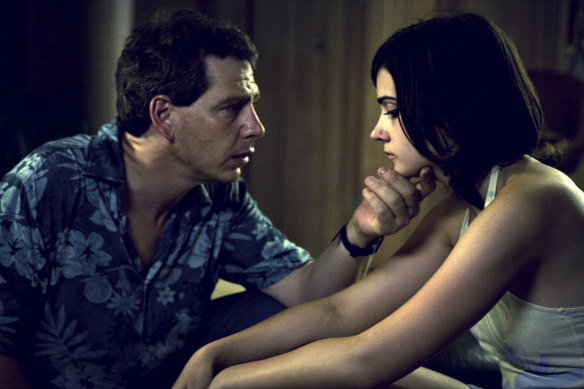
Ben Mendelsohn and Laura Wheelwright in Animal Kingdom.
“She’s incredible, and it’s an incredible achievement,” Mendelsohn says. Muller Serreau’s knowledge, he says, was critical in filling the gaps in his own. “I try as much as I can to swim in my lane and [depend on] those who are expert to tell me what it’s going to be. I approach it much more like a kelpie, than I do as a guy that stands at the top with a sense of solid knowing.
“And when I go and do it on the floor, I’m not giving you a certainty, I’m just giving a proposition,” Mendelsohn adds. “It’s just a proposition every time. And I’m standing well beneath an audience, trying to offer it up, imagining you as much more able to read and understand things than I am, but giving it my best and trying to do so with sort of a love letter vibe.”
In one sense, Mendelsohn doesn’t give himself enough credit. His performance in The New Look is remarkable, the confirmation of an actor whose career has taken him from Danny Clarke in The Big Steal (1990) and Dazey in Metal Skin (1994), to Pope in Animal Kingdom (2010) and Henry IV in David Michod’s The King (2019), with a thrilling stopover in Rogue One, as Orson Krennic, in an unforgettable face-to-mask meeting with Darth Vader.
“They are all there, [but] it’s very easy to confuse the piece that an audience takes to be the thing that it was [because] what you carry with you is the whole history of working those long, long days in those long, long things.” Mendelsohn adds that much of the time he was “not necessarily feeling very confident about anything, or while demonstrating this sort of pose of like, yeah, I can do it all.”
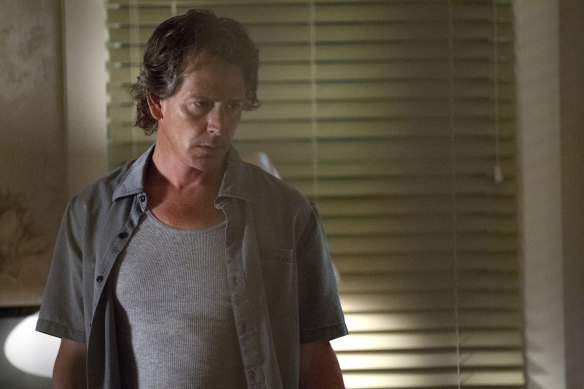
Ben Mendelsohn in Bloodline.
When he looks in the mirror, even in costume, he still sees himself, not the character he is playing. “When I was younger, it bothered me a lot more; the real thing I lament about [the face] is its pathways are very, very set. I used to wish that I could somehow train the face to do completely different things, But what happened is that I’ve become less concerned with trying to control it or trying to manoeuvre it for effect.”
But, he adds, there are echoes of all them – Danny, Dazey, Pope, Orson Krennic and Henry IV – still with him. “They’re all there. And the ones that are the most important end up being the ones that people love, and Babyteeth, for instance, will remain incredibly important, whether or not it’s taken up,” he says.
“When people love them, they stay in you,” he says. “Danny, Trevor [from 1987’s The Year My Voice Broke], there’s a lot of them ... just moments, moments and moments. And I’ve got 40 years of them, mate. I wasn’t looking to become an actor. I really wasn’t. I wouldn’t have dreamed of it. I wouldn’t have dreamed of it.”
The New Look is on Apple TV.